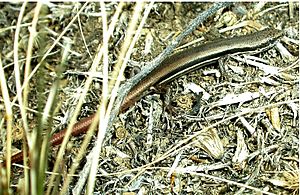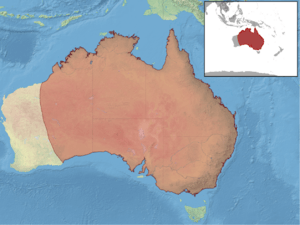Morethia boulengeri facts for kids
Quick facts for kids Morethia boulengeri |
|
|---|---|
 |
|
| Conservation status | |
| Scientific classification | |
| Genus: |
Morethia
|
| Species: |
boulengeri
|
 |
|
| Synonyms | |
|
|
The Morethia boulengeri is a small lizard that belongs to the skink family. This special lizard is only found in Australia, meaning it is endemic to that continent.
Contents
Meet the Boulenger's Skink
This lizard has several common names. People often call it the south-eastern Morethia skink, Boulenger's snake-eyed skink, Boulenger's Morethia, or simply Boulenger's skink.
Why "Boulenger's"?
The scientific name, boulengeri, and many of its common names, honor a famous scientist. This scientist was George Albert Boulenger. He was a Belgian-born British herpetologist. A herpetologist is someone who studies reptiles and amphibians. Boulenger described many new species of reptiles, amphibians, and fish during his career.
What Does It Look Like?
The Morethia boulengeri can look quite different from one lizard to another. Generally, it is grey or brown. It often has darker spots or flecks that run in lines down its back. Its belly is mostly white.
A thin white stripe runs from its mouth all the way to its back legs on both sides. Above this white line, there is a thicker black stripe. Young lizards have a bright red-orange color on the underside of their tail. This special color helps tell them apart from other types of lizards.
Size of the Skink
Boulenger's skink can grow up to 10 centimeters (about 4 inches) long, including its tail. But on average, it is about 8 cm (about 3 inches) from its nose to the tip of its tail. From its nose to where its tail starts, it's usually about 4.5 to 5 cm (about 2 inches). This skink also has square-shaped scales right above its eyes.
Where Does It Live?
As mentioned, the Morethia boulengeri is only found in Australia. You can find it in most parts of the country, in every state and territory except Tasmania. This lizard is a "generalist" species. This means it can live in many different kinds of environments. It prefers dry and very dry areas.
Its Home Environment
You can find these skinks living among fallen leaves and dead plants. They live in many types of dry forests and bushy areas. These include dry sclerophyll forests, mallee, deserts, scrublands, and woodlands. They are very common in the area around the Murray River in southern New South Wales. Sometimes, hundreds of these skinks can live in just one hectare of land!
What Does It Eat?
The Morethia boulengeri is an insectivorous species. This means it mostly eats insects and other small creatures. Its diet mainly includes arthropods and snails. Moths make up a big part of what it eats. Spiders, beetles, ants, cockroaches, and other bugs are also on its menu. All these prey animals are easy to find in Australia and in the leaf litter where the skink lives.
Reproduction and Life Cycle
Morethia boulengeri lizards mate during the warmer months, in spring and summer. When it's time to mate, the male skink's throat turns a bright orange color. This tells the female that he is ready to find a partner.
This type of skink is oviparous, which means the female lays eggs. A female Morethia boulengeri usually becomes old enough to have babies within her first year of life. On average, she lays about three eggs in each group, called a clutch. A female can produce about three clutches of eggs each year. The eggs are kept warm, or incubated, for about 60 days before they hatch. During this time, the eggs use a lot more oxygen as the babies grow inside.


